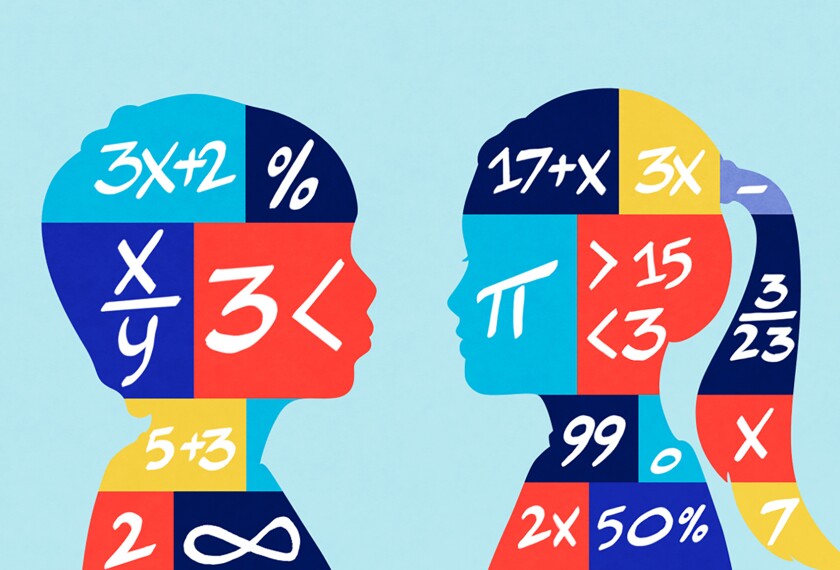The pandemic didn’t just affect students’ reading and math achievement—it brought a drop in science skills too, according to a new national analysis of test data.
While scores have almost fully rebounded for elementary school children since then, they’re continuing to decline for students in 7th and 8th grades, according to new research released Sept. 17.
The research, from assessment provider NWEA, is one of the first large-scale examinations of academic performance in the subject in the wake of COVID-era disruptions. The findings suggest long-lasting consequences for students whose upper elementary science education was affected by the pandemic.
During the 2020-21 school year, the middle schoolers in the study were in 4th or 5th grades—a grade band that has outsize influence for science education, said Susan Kowalski, a senior research scientist at NWEA and the lead author of the study.
The subject usually gets short shrift in elementary school classrooms, squeezed into the master schedule between the primary concerns of reading and math. But under federal law, most states test science for the first time in 4th or 5th grades. As such, schools give it higher priority during those years, said Kowalski.
Amid school closures and remote learning, current middle schoolers likely didn’t get that experience in their upper elementary years.
“We suspect that a lot of kids missed out on elementary science altogether,” she said.
Science in the early grades introduces key skills that students will continue to develop throughout K-12—practices such as planning investigations or developing models.
It also lays the groundwork for learning higher-level concepts later on. For instance, 4th graders who learn about the function of different parts of plants—like roots and stems—might rely on that knowledge to build their understanding of plant cell systems when they reach middle school.
But during the pandemic, it’s likely that many students entered middle school without this foundation, Kowalski said.
Gaps widening the most for Hispanic students
NWEA researchers analyzed scores on the organization’s science interim assessment from students in grades 3-8 in 621 schools across the country, between spring 2019 and spring 2024.
Compared to students in the same grade in spring 2019, students in spring 2021 had lower scores—amounting to one to 2.3 months of unfinished learning. These gaps have been closing for younger students over the past three years, but have only widened for older students.
The study also found uneven effects across racial and ethnic groups. Hispanic middle schoolers have lost even more ground than their white peers in the same grades, meaning that the racial disparities between Hispanic and white students have grown since the beginning of the pandemic. In spring 2024, for example, Hispanic 8th graders were 6.3 months behind their 2019 peers, while white students were only 1.6 months behind theirs.
This disparity warrants more research, said Alicia Conerly, the president of the National Science Teaching Association, and an instructional specialist in the Marion County schools in Mississippi. (Conerly was not involved with the NWEA report.)
It’s possible that interrupted science education affected English learners—more than three-quarters of whom are Hispanic—more than other students, Conerly said, given the subject’s reliance on discipline-specific language. For example, words such as “wavelength” and “amplitude” have specific, technical meanings in science that teachers would need to define.
Overall, science achievement didn’t take as great a hit during the pandemic as reading and math achievement on NWEA’s measures. Previous research from the organization has found that, in spring 2024, students across grades 3-8 still faced up to about 9 months of lost learning in reading and math, compared to up to about 3 months in science.
This smaller dip could reflect science’s lower position in the hierarchy of school subjects, said Kowalski. Even before COVID, students spent comparatively less time on science. In grades 4-6, for example, students spend on average 27 minutes daily in the subject, while they spend 82 minutes in reading, according to a 2018 study.
“When you go from 27 minutes to 0, that’s not as big of a drop from 82 minutes to 0,” Kowalski said.
Could reading classes make room for more science content?
As districts have crafted academic recovery plans, most leaders have prioritized what they see as foundational subjects. Science doesn’t always make the cut.
But there are ways to increase students’ exposure to science content without necessarily increasing time set aside for the subject, Kowalski said.
In middle school science classes, for instance, students should be investigating scientific phenomena and learning discipline-specific practices, like forming hypotheses. But they can also read about science in English/language arts classes through complementary expository texts, she said.
This is an opportunity for schools to harness the “new, urgent focus on knowledge building” in ELA classes, said Lindsay Dworkin, the senior vice president of policy and government affairs at NWEA.
Conerly agreed that integrating more science content throughout the school day could benefit students. She emphasized that ELA teachers need some background knowledge in the subject to do so well—otherwise, Conerly said, there’s a risk of introducing misinformation.
Still, students could easily practice in ELA the skills they need to understand science texts.
“It’s all about the questioning and reasoning, the critical thinking skills being imparted into the student,” she said.
Disclaimer: The copyright of this article belongs to the original author. Reposting this article is solely for the purpose of information dissemination and does not constitute any investment advice. If there is any infringement, please contact us immediately. We will make corrections or deletions as necessary. Thank you.





